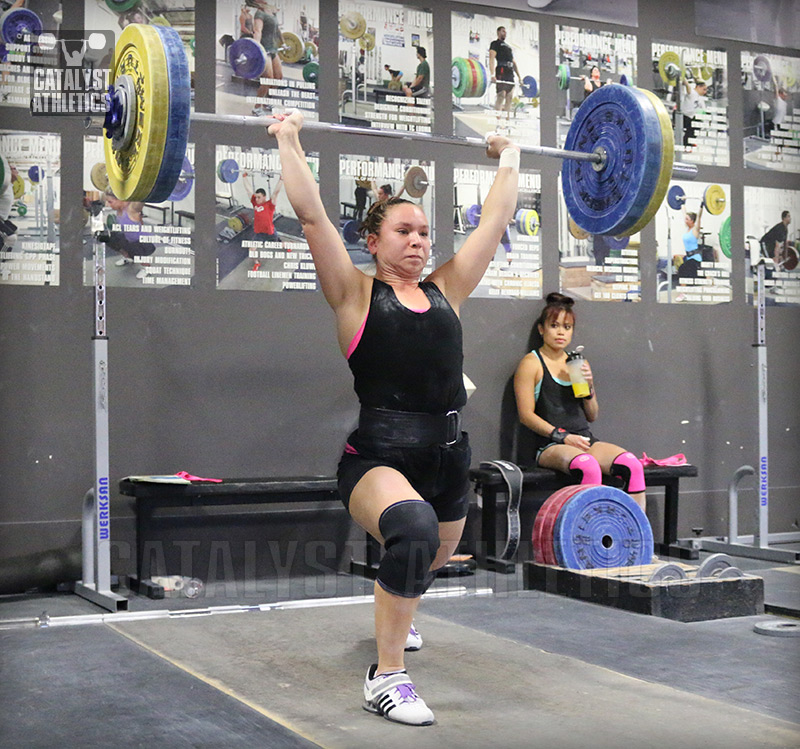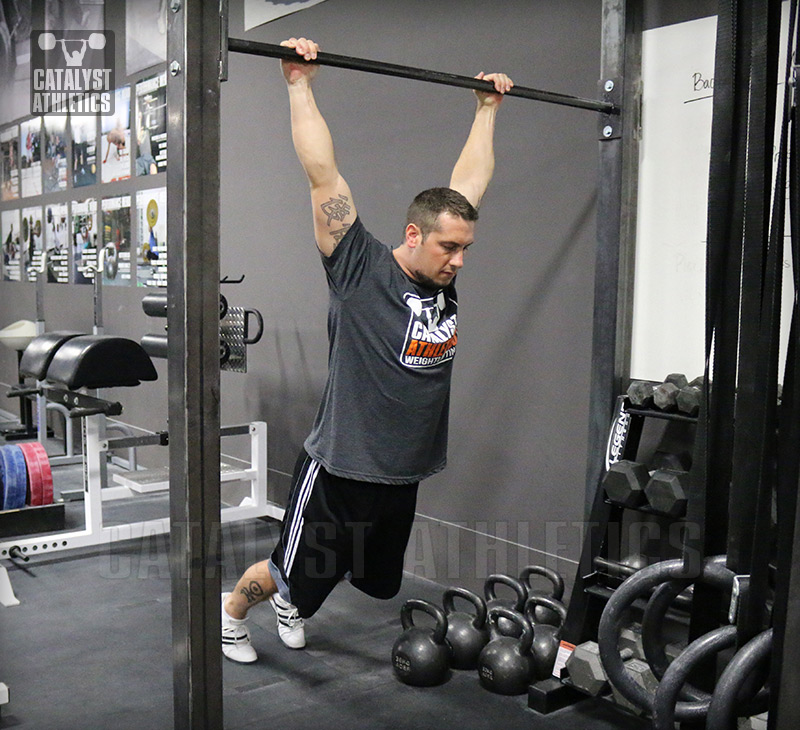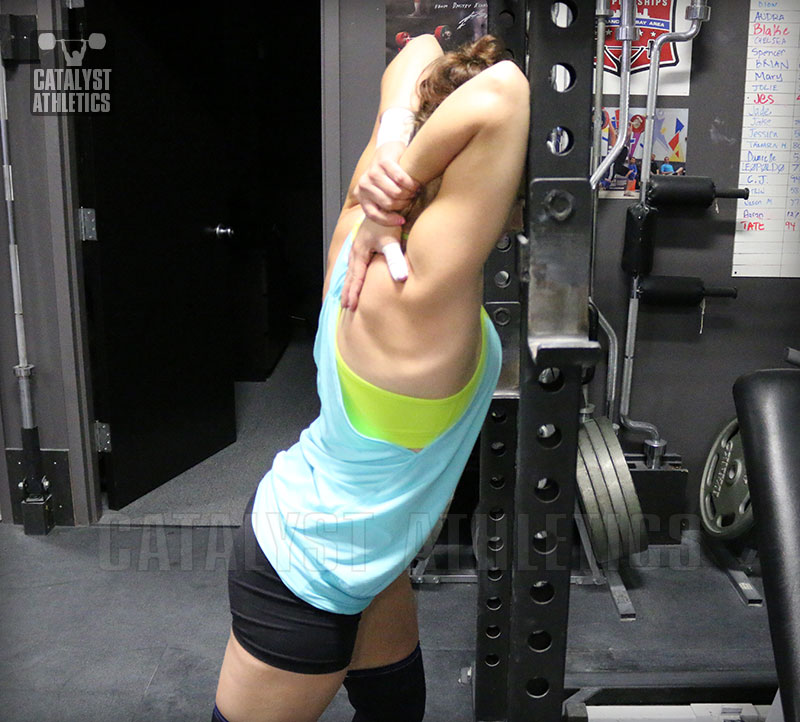Articles
Real World Overhead Mobility for Weightlifting
August 3 2015

Door Jamb Pec Stretch This is another very simple stretch that works wonders. With the elbow somewhat bent and higher than the shoulder, place the forearm on a door jamb (or power rack upright, stall bar upright, etc.) and push the chest forward to open the shoulder girdle.

Door jamb pec stretch
Third, we make sure she is warming up well—I’m frequently surprised how this one goes overlooked by so many people. Failing to warm up adequately means not even being able to access whatever range of motion you do have.
Fourth, I use training exercises to address overhead strength and stability directly. Some of these I use pretty commonly with all lifters (e.g. overhead squat, snatch push press, press in snatch), but others I typically use only when there is a specific need for the given lifter. The following exercises are ones I use regularly with Alyssa. You can click on each for a video demo and information about execution and programming.
August 3 2015

Matt Foreman wrote a flattering article about one of my lifters, Alyssa Sulay, last week and we received quite a few requests for more information about what exactly Alyssa and I have done to improve her overhead position. I’m going to try to provide a clear outline of what we’ve done in the last nearly four years to take her from barely able to overhead squat 30kg to snatching 83kg.
Keep in mind that her overhead position is not totally fixed; in fact, it’s still by far her biggest limiter for the snatch and jerk. However, she can now snatch 83kg, jerk 105kg and power jerk 100kg at 63k bodyweight, so she has made incredible progress with it. Also keep in mind that she trains 5-9 times/week and is extremely dedicated to weightlifting; she has put in a lot of consistent effort over a long period of time to make the progress she has. Don’t expect to implement the information in this article and resolve your overhead problems in a few weeks.
Alyssa thankfully is very mobile in the ankles and hips, but other athletes need to be sure to evaluate lower body flexibility to ensure it’s not responsible for, or at least contributing to, limitations in the overhead position. This often goes overlooked—in many cases, the upper back and shoulders are more than adequately mobile, but limitations in ankle and hip flexibility place the lifter in a poor squat position that the upper body must try to make up for.
Most of the work Alyssa has done for the problem has been in the gym, but she has also been doing work outside the gym, including fairly regular appointments with a chiropractor who also does a lot of soft-tissue work.
We can break up the work loosely into two basic categories: mobility and strength/stability.
Mobility
Alyssa has two basic mobility issues—her shoulder girdle is very tight, i.e. short pecs, and her thoracic spine is hyperkyphotic with limited mobility. These two things combined destroy a lifter’s overhead mobility and stability by preventing the establishment of the proper structure regardless of strength and technical ability.
Obviously her mobility work is focused on getting her thoracic spine into a better position and stretching her shoulder girdle. For thoracic spine mobility, we do quite a few things, and over the years have done more than I can include here. However, the most important and most used are the following:
Foam Rolling Rolling over the upper and mid-back with the roller perpendicular to the spine is something Alyssa does up to multiple times daily, but at a minimum, as part of her pre-training routine. This is a very simple, easy way to get some movement in the T-spine and starting loosening it up. Along with rolling, she will simply lie over the roll, usually with her arms stretched overhead, and try to relax to get the spine to settle over the curve of the roll. She’ll spend several seconds on a few different locations from the mid to upper back.
Half Round Another variation of this we have used is for her to lie over a chunk of white foam roller I cut into about 4 inches wide and a half-round shape. She lies with her T-spine curving over this, just like with the regular foam roller, but this is a little easier to do for long periods of time because it’s lower and a bit softer. She will sometimes do this while holding a plate in each hand with her arms out in a 90/90 orientation (upper arm 90 degrees from the body, and elbows bent to 90 degrees). This combines T-spine mobility and shoulder girdle stretching.
Leaning Bar Hang This is one of my go-to shoulder girdle stretches—it’s simple, unglamorous, and effective, just the way I like stretches. Hanging from a pull-up bar with about a jerk-width or slightly wider grip and keeping her toes on the floor (or on a box as needed) a couple feet behind the bar, she will hang from the bar while leaning her chest forward through her arms (the feet on the floor allow her to create that forward lean, but also allow the body to relax a bit more into the stretch. The convenient bonus of this stretch is that it provides some nice traction for the lower back, which is very beneficial for lifters.

Leaning bar hang

Leaning bar hang
Door Jamb Pec Stretch This is another very simple stretch that works wonders. With the elbow somewhat bent and higher than the shoulder, place the forearm on a door jamb (or power rack upright, stall bar upright, etc.) and push the chest forward to open the shoulder girdle.

Door jamb pec stretch
Underarm Stretch Again, simple and effective. I always laugh when I see people tying themselves up with a band to do a stretch like this and doing nothing but making it more complicated and less effective. Lift your arm overhead and bend the elbow completely, and place the backside of your upper arm near the elbow against a power rack upright or similar. Keeping your abs tight to avoid lumber hyperextension, lean forward to open the shoulder as much as possible. Use your free hand to hold the wrist of the arm being stretched and push it out to the side somewhat.

Underarm stretch

Underarm stretch
Partner T-spine Mobilization This is one that our team chiropractor showed me a couple years ago that has proven to be very helpful, and is something I do with Alyssa before every workout. Basically Alyssa is on her knees with her arms overhead and elbows supported on a box or bench to orient her trunk horizontally, and I use my thumbs on either side of her spine to push down, moving up and down her mid and upper back, to get some movement in her very tight and hyperkyphotic back.

Partner T-spine Mobilization

Partner T-spine Mobilization
Bust Stretch This is a hilarious name for the stretch. If it’s not funny to you, you don’t get it (hint: there is a double meaning) or you’re boring and have no sense of humor. I do this stretch with Alyssa right after we do the partner T-spine mobilization. She will sit on her knees and place her hands behind her head. I will place one of my thighs against her back to brace it, then pull her elbows back toward myself. I will also sometimes stretch her with her arms reaching straight overhead by holding the upper arms and pulling them back.

Bust stretch

Bust stretch
Stability & Strength
Coupled inseparably with mobility is stability—the two have to exist at equal levels for things to work properly. The overhead position for the snatch and jerk are perfect examples of this—having adequate mobility to achieve the proper position isn’t that helpful if a lifter can’t maintain the position under load. This is partly a function of strength, but also an independent factor of proprioception, etc. I combine the two here because there is a lot of overlap, especially in the way we train them.
First, we do things with snatches and jerks like hold the bar overhead (usually in the squat or split) for 2-3 seconds before recovering. This, as I’ve written about multiple times, is an effective way to improve both overhead strength and stability, and adds no real time to the lifter’s workouts like additional exercises do.
Second, we work on correcting all the technical faults that contribute to overhead instability. The more precise a snatch or jerk, the easier holding the bar overhead is because additional and unpredictable movement are minimized. For Alyssa specifically, this means getting rid of her forward jump in the snatch and her forward dip in the jerk.
Third, we make sure she is warming up well—I’m frequently surprised how this one goes overlooked by so many people. Failing to warm up adequately means not even being able to access whatever range of motion you do have.
Fourth, I use training exercises to address overhead strength and stability directly. Some of these I use pretty commonly with all lifters (e.g. overhead squat, snatch push press, press in snatch), but others I typically use only when there is a specific need for the given lifter. The following exercises are ones I use regularly with Alyssa. You can click on each for a video demo and information about execution and programming.
Putting it to Use
The most important thing to know with regard to improving overhead mobility (and mobility in general) is that it requires a frustrating combination of consistency and patience: it will not be a quick fix.
Some of the above exercises should not be used for individuals with extreme inflexibility—behind the neck exercises should be avoided if it causes pain. Push presses behind the neck will probably be the first that become accessible as flexibility improves, as the momentum created by the legs carries the bar through the most limited range of motion and consequently reduces the demand on the shoulder structures. The amount of leg drive can be reduced, and/or the weight increased, over time as mobility improves.
The bottom line is this: do as much mobility work each day as you can stand, do it consistently for a long period of time, include exercises in your training that help create or maintain mobility and strengthen and stabilize the overhead position, and expect it to be a long, boring process.

Really outstanding article. Simple, straightforward, and useful.
Thank you!
http://www.strongsidecrossfit.com/
Thanks!
As a PT I am seeing more and more "shoeless" power lifters squatting in gyms. Is there any biomechanical advantage or factuality involved with this trend? Also under what circumstances if any, would you suggest squatting with raised heels. Can it help protect the knees and lower back for those who are just after strengthening and conditioning no competitive athlete?
While once upon a time I thought I had a clear mind on this know I am unsure but I am finding it difficult to locate some exact science on these variations.
Regards